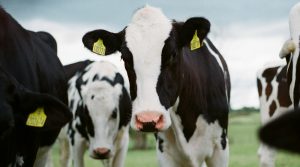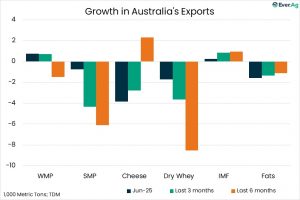
“Our relevance on global markets is being questioned because of our shrinking scale and competitiveness,” the Australian Dairy Situation Analysis report found.
“In the late 1990s Australian dairy supplied around 16 per cent of measured world exports of dairy products.
“The two largest local firms (MG and Fonterra) each separately accounted for about 5 per cent of total world trade by volume.
“By 2018, Australian dairy’s share of (an admittedly expanded) export trade has fallen to around 6 per cent. No local firm accounts for anywhere near 2 per cent of this trade.”
Just how far Australia has fallen is reinforced by the fact the global dairy export trade has grown by more than 2.5 million tonnes or 21 per cent in the six years to 2018, while Australian dairy exports grew by 22,364 tonnes or just 3 per cent over the
same period.
And the situation is only set to get worse with Dairy Australia’s latest production statistics showing national milk production fell 6.7 per cent in the first nine months of the 2018-19 season to just 6.82 billion litres, compared to 7.32 billion for the same period last season.
The confronting situational analysis was released by Dairy Australia ahead of farmer consultations on the development of an Australian Dairy Plan, which will attempt to map out the industry’s future.
Dairy Plan chairman John Brumby said the report “provides an honest assessment of challenges that we hope will be addressed during the course of the consultations”.
The report outlines the impacts of the dairy industry’s transformation from co-operatives to one majority-owned by global corporations, such as Fonterra, Lactalis, Saputo and Kirin Breweries, who can source globally and accountable to their shareholders or parent company, not Australian farmer members.
“These new ownership structures add complexity to traditional country of origin marketing because multinationals operate in multiple jurisdictions,” the report states.
“In that context they are now looking to manage potential regional risk that come with limiting marketing efforts to only one country of origin.”
The report also warned the multinationals who have invested $3 billion in Australia over recent years are struggling to gain a decent return on the back of the milk supply slump.
“The combination of a gradual decline in dairy production volumes, competition for milk at the farmgate and significant competition from imported dairy in Australian domestic market is ratcheting up the challenges faced by processors in the Australian market,” the report concludes.
“This shortage of milk also means processors have needed to buy milk off each other to fill contractual obligations.
“This milk is often procured at a price higher than average farmgate milk prices off the liquid milk spot market. This is not an open and transparent market, so farmers do not receive pricing signals to produce more milk on the basis of these interprocessor purchases of milk.”
The Weekly Times is aware of milk that is already being traded by milk brokers at $7 a kg milk solids.
“A combination of the declining milk pool and choices to export dairy product to some markets rather than focus on the domestic market has opened the door for significant growth in dairy imports, which have more than doubled in the last decade.”

![Marketing of infant formula must be regulated 1 A nurse instructs a mother in the process of breast milk donation at the Maternity and Child Care Center in Qinhuangdao, Hebei province, last year. The milk is provided to premature and critically ill infants whose mothers cannot produce enough milk. [Photo by CAO JIANXIONG/FOR CHINA DAILY]](https://en.edairynews.com/wp-content/uploads/2019/05/Marketing-of-infant-formula-must-be-regulated-150x150.jpeg)






















